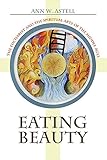Eating Beauty : The Eucharist and the Spiritual Arts of the Middle Ages / Ann W. Astell.
Material type: TextPublisher: Ithaca, NY : Cornell University Press, [2016]Copyright date: ©2016Description: 1 online resource (312 p.) : 12 halftones, 1 chart/graphContent type:
TextPublisher: Ithaca, NY : Cornell University Press, [2016]Copyright date: ©2016Description: 1 online resource (312 p.) : 12 halftones, 1 chart/graphContent type: - 9781501704550
- Aesthetics -- Religious aspects -- Catholic Church
- Food -- Religious aspects -- Catholic Church
- Lord's Supper -- Catholic Church -- History of doctrines -- 16th century
- Lord's Supper -- Catholic Church -- History of doctrines -- Middle Ages, 600-1500
- Spiritual life -- Catholic Church -- History of doctrines -- 16th century
- Spiritual life -- Catholic Church -- History of doctrines -- Middle Ages, 600-1500
- Medieval & Renaissance Studies
- Religious Studies
- HISTORY / Medieval
- eating beauty, Christian, literature, spirituality, aesthetics, interpretation
- 234/.16309 23
- BV823 .A77 2016eb
- online - DeGruyter
| Item type | Current library | Call number | URL | Status | Notes | Barcode | |
|---|---|---|---|---|---|---|---|
 eBook
eBook
|
Biblioteca "Angelicum" Pont. Univ. S.Tommaso d'Aquino Nuvola online | online - DeGruyter (Browse shelf(Opens below)) | Online access | Not for loan (Accesso limitato) | Accesso per gli utenti autorizzati / Access for authorized users | (dgr)9781501704550 |
Browsing Biblioteca "Angelicum" Pont. Univ. S.Tommaso d'Aquino shelves, Shelving location: Nuvola online Close shelf browser (Hides shelf browser)

|

|

|

|

|

|

|
||
| online - DeGruyter Running the Rails : Capital and Labor in the Philadelphia Transit Industry / | online - DeGruyter Making Morocco : Colonial Intervention and the Politics of Identity / | online - DeGruyter Strategic Coupling : East Asian Industrial Transformation in the New Global Economy / | online - DeGruyter Eating Beauty : The Eucharist and the Spiritual Arts of the Middle Ages / | online - DeGruyter Summerfolk : A History of the Dacha, 1710–2000 / | online - DeGruyter Ikki : Social Conflict and Political Protest in Early Modern Japan / | online - DeGruyter Geology in the Nineteenth Century : Changing Views of a Changing World / |
Frontmatter -- Contents -- List of Illustrations -- Acknowledgments -- List of Abbreviations -- 1. “Taste and See” -- 2. The Apple and the Eucharist -- 3. “Hidden Manna” -- 4. “Adorned with Wounds” -- 5. “Imitate Me As I Imitate Christ” -- 6. The Eucharist, the Spiritual Exercises, and the Art of Obedience -- 7. Weil and Hegel -- 8. To ( Fail to) Conclude -- Appendix -- Bibliography -- Illustration Credits -- INDEX
restricted access online access with authorization star
http://purl.org/coar/access_right/c_16ec
"The enigmatic link between the natural and artistic beauty that is to be contemplated but not eaten, on the one hand, and the eucharistic beauty that is both seen (with the eyes of faith) and eaten, on the other, intrigues me and inspires this book. One cannot ask theo-aesthetic questions about the Eucharist without engaging fundamental questions about the relationship between beauty, art (broadly defined), and eating."—from Eating BeautyIn a remarkable book that is at once learned, startlingly original, and highly personal, Ann W. Astell explores the ambiguity of the phrase "eating beauty." The phrase evokes the destruction of beauty, the devouring mouth of the grave, the mouth of hell. To eat beauty is to destroy it. Yet in the case of the Eucharist the person of faith who eats the Host is transformed into beauty itself, literally incorporated into Christ. In this sense, Astell explains, the Eucharist was "productive of an entire 'way' of life, a virtuous life-form, an artwork, with Christ himself as the principal artist." The Eucharist established for the people of the Middle Ages distinctive schools of sanctity—Cistercian, Franciscan, Dominican, and Ignatian—whose members were united by the eucharistic sacrament that they received. Reading the lives of the saints not primarily as historical documents but as iconic expressions of original artworks fashioned by the eucharistic Christ, Astell puts the "faceless" Host in a dynamic relationship with these icons. With the advent of each new spirituality, the Christian idea of beauty expanded to include, first, the marred beauty of the saint and, finally, that of the church torn by division—an anti-aesthetic beauty embracing process, suffering, deformity, and disappearance, as well as the radiant lightness of the resurrected body. This astonishing work of intellectual and religious history is illustrated with telling artistic examples ranging from medieval manuscript illuminations to sculptures by Michelangelo and paintings by Salvador Dalí. Astell puts the lives of medieval saints in conversation with modern philosophers as disparate as Simone Weil and G. W. F. Hegel.
Mode of access: Internet via World Wide Web.
In English.
Description based on online resource; title from PDF title page (publisher's Web site, viewed 26. Apr 2024)


